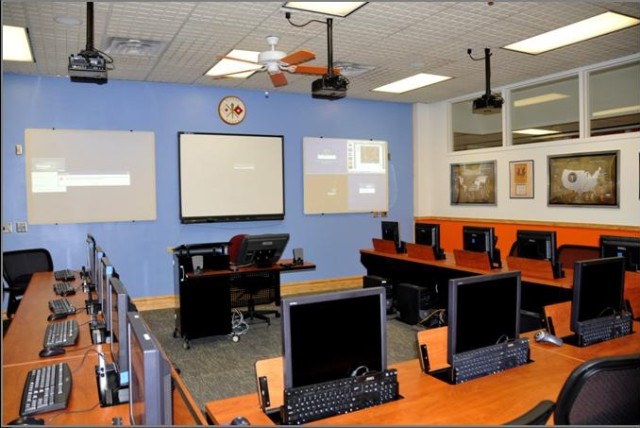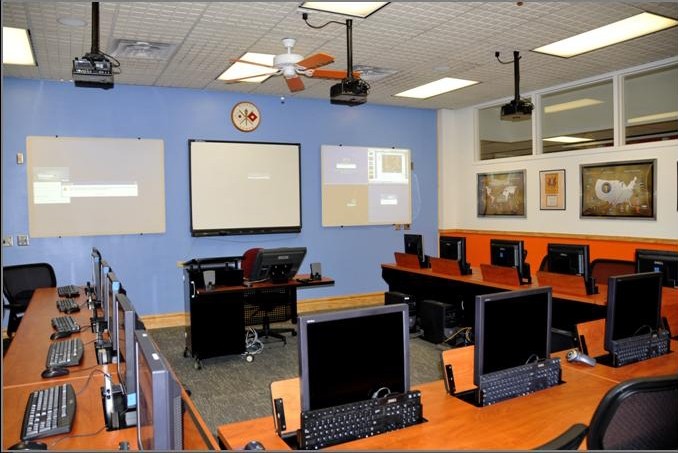Fort Bliss, Texas - First Sergeant John Ordway's journey of discovery did not end in the Fall of 1806 as is noted in the history books. In fact, truth be told, it never ended. It continues today through the brotherhood of the noncommissioned officer corps and the spirit of Ordway, the quintessential first sergeant, in leading the way into the future of the Noncommissioned Officer Education System at the U.S. Army Sergeants Major Academy. Classroom "Mike 09" sits empty for the moment. Eighteen student-stations fully equipped with internet-connected thin client computers, three projection presentation boards including a smartboard, and a floatable instructor station await the first utterances of education that will surround Class 59 of the Sergeants Major Course come 8 August. It is a room that is aptly named after Ordway, a pioneer of discovery, and is akin to the Lewis and Clarke room at the Command and General Staff College, Fort Leavenworth, Kan., in that it is ushering in a transformation to the way the Army educates it's senior NCOs. "The main principle of the 1st Sgt. Ordway classroom is to help in the NCOES transformation that is mandated by the Chief of Staff and guidance given by the Sergeant Major of the Army on NCOES," said Sgt. Maj. Efrin Ordaz, senior instructor for Military Operations at USASMA. "The Ordway room with the thin client brings total technology capabilities to the SMC course. For most of the time it is a general purpose classroom, but it transforms into a command post or tactical command post for the end of course exercise." Ordaz said the use of thin client in the room allows the Academy to tie into the Battle Staff Digital Training program without having to leave the classroom, and allows the students to access all course materials online, eliminating the need for hard copy paper reproductions. When Class 59 begins in August the students will be issued the normal compliment books, field manuals and courseware for use in class while USASMA personnel are trained on the intricacies of thin client. Once that familiarization and training is complete Class 59 will turn in all of their Army materials and begin using thin client. "This academy spends more than $150K in reproduction of materials for instruction. Thin client will be a 95 percent solution to that in that all military references will be on the thin client," Ordaz said. "Research will also be done in the classroom and the students will be able to save their work to their AKO accounts for later review at home on their personal computers. The only references not being done away with are the civilian resource books." The use of thin client will also eventually allow the SMC classrooms the ability to connect between classrooms, conduct video teleconferencing with outside agencies and individuals and to access a SIPRNET (secure internet protocol router network). "We wanted a classroom that will have the capability to continue to evolve. This is no longer just a box with four walls," he said. The Ordway room will eventually be replicated throughout the entire academy, but for now only the Military Operations classrooms have the full compliment. Phase II of the project will occur as monies are made available. Once completed, this "tool in the toolbox" will help the academy transform the SMC into something very different from what past graduates are familiar with. "Thin client is just a tool, but the Sergeants Major Course redesign; which the academy is working on right now; is going to have a profound impact on the individual graduate. The Chief of Staff of the Army said he wants to build intellectual capacity, he wants to transform NCOES, and he wants us to accelerate that transformation," said Command Sgt. Maj. Raymond Chandler the academy command sergeant major. "One of the ways we are going to achieve his directive is to synchronize our NCOES courses with the officer education system." Chandler explained that a major graduates from CGSC at about the same time (time in service) as a sergeant major graduates from USASMA. Both courses are roughly the same length and are supposed to produce a graduate who is effective in his/her next unit of assignment. The two courses are not in sync, however, because the SMC does not produce a graduate that understands the operational and strategic implications for the Army. "Our objective is to get those two courses in sync with one another, so both of those graduates when they go to their next level of assignment are on the same wavelength. They can speak the same language, they understand the same terms and so the sergeant major is just as well grounded in that operational and strategic learning as the major is," he said. "They are not the same course; they are not ever going to be the same course; but it is important to ensure that they both learn similar things to support the nation's Global War on Terrorism." Chandler said for Class 59 some 28 lessons have been rewritten based on doctrinal changes and the curriculum for Class 60, the first class to be all sergeant major selectees with no non-promotable master sergeants in attendance, is yet to be determined. "The course itself will be fundamentally different from what we do now. We don't know exactly what that all is going to look like, but like I stated, that synchronization between CGSC and the SMC is the first step," Chandler said. "We are going through a process right now in that by the middle of August, Company A is going to turn over their initial analysis to the directorate of doctrine and training for them to start working on the course map and development to fill the need to redesign the course." Some things for sure will be dropped - how to conduct PT or how to conduct counseling - the basic leadership skills that Chandler said by the time you make it to the SMC, you shouldn't need training on. In fact, he said training is not going to be the main objective of the SMC. "The overarching intent is we want to get away from the training aspect and more toward education. When you get to this level in the Army there are very few things that you need to be trained on," he said. "But you need education and the difference between the two is in training you are being taught what to think, in education you are learning how to think and solve problems. That is what the goal of the course is going to become to immerse students in an environment where they are learning continuously throughout the entire year that they are here." And the 1st Sgt. Ordway model classroom will still be leading the way, ever looking forward and adapting to the terrain to keep the NCO Corps out front blazing a trail to the future.
Ordway blazes new trail of discovery for USASMA
By David Crozier, NCO JournalJuly 18, 2008




Social Sharing